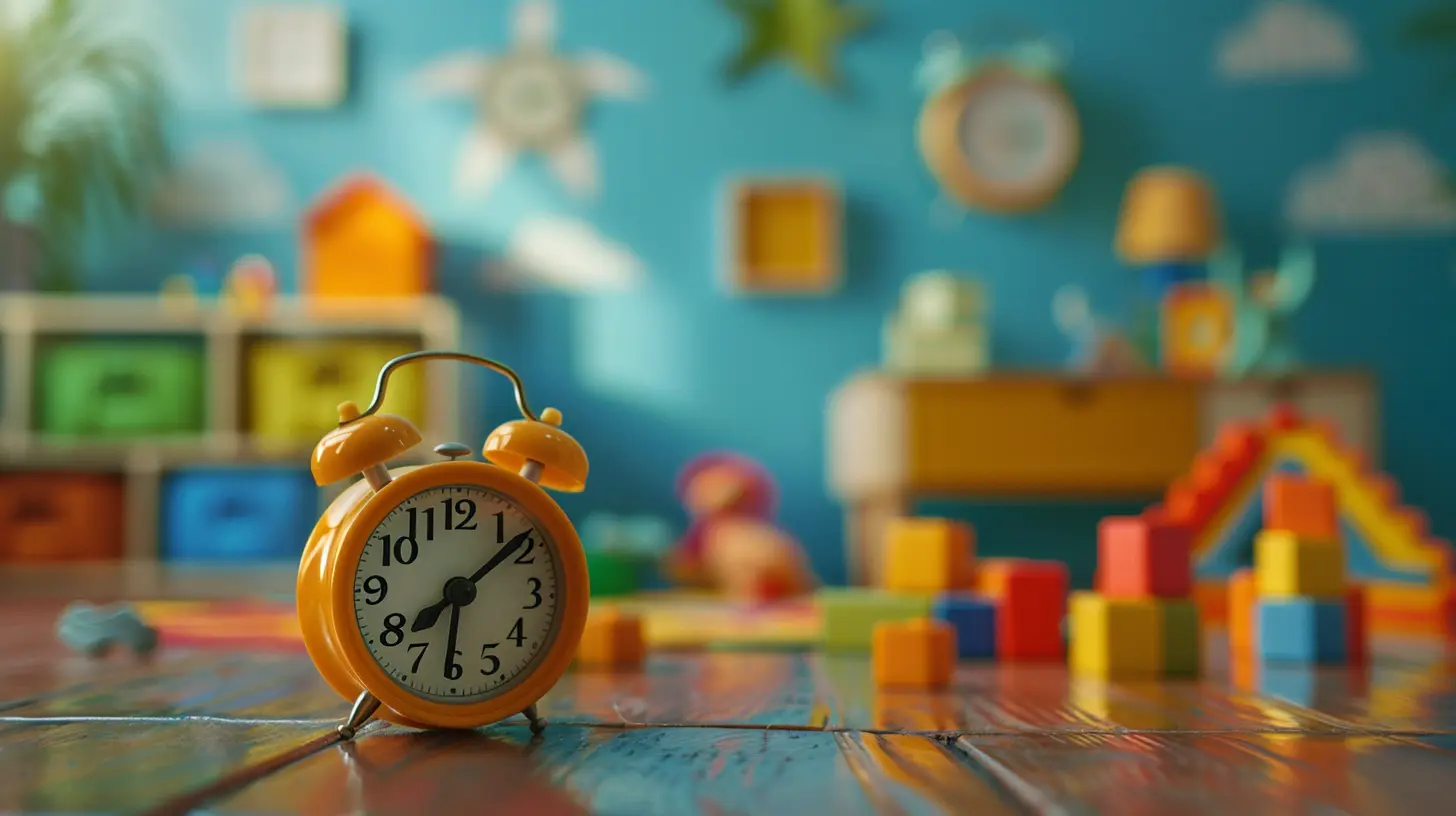Managing Difficult Transitions with Routine Anchors
6 November 2025
Life is filled with transitions. Some are monumental—like starting school, moving to a new home, or welcoming a new sibling—while others are more subtle and routine, like the end of a playdate or getting ready for dinner. For kids, even the smallest of transitions can sometimes feel overwhelming. As parents, our job is to help them navigate these moments fairly smoothly. But let’s be real—it’s not always easy!
One strategy that can make all the difference? Routine anchors.
So, what exactly are these "routine anchors," and how can they help manage difficult transitions? Let's dive in.

What Are Routine Anchors?
Routine anchors are consistent, predictable activities or cues that punctuate different parts of the day. Imagine them like the sails on a ship—they keep things steady, even when the winds of change pick up. These anchors provide structure and a sense of security, helping your child mentally and emotionally prepare for what’s coming next.Think about it: Have you ever seen a child become completely unraveled just because it’s time to leave the park? Yeah, I’ve been there too. This is where routine anchors come in handy. A steady routine before transitions helps cushion the emotional jolt that can come with change.

Why Transitions Are So Tough for Kids
Transitions—be they big or small—can be rough seas to navigate, especially for younger kids. But before we jump into creating anchors, let’s first understand why transitions can be so challenging for children.1. Routine Disruption: Kids thrive on predictability. When something unexpected happens like leaving a fun activity or heading to bed, it messes with their sense of stability. Even if it’s an everyday thing like mealtime, the abrupt change can still be jarring if they’re not ready for it.
2. Developmental Changes: Kids, especially toddlers and preschoolers, tend to live in the moment. They don’t have that developed sense of time that allows them to understand what’s happening next. In their minds, leaving the park could very well feel like the end of the world!
3. Emotional Overload: Transitions often occur when emotions are already heightened—during playtime, while sleepy, or after a long day. This emotional turbulence makes it harder for children to regulate their responses to a sudden change.
4. Lack of Control: Adults often make all the decisions in children’s lives, including when transitions happen. Ever notice how kids tend to dig their heels in when they feel like they don’t have control? Yeah, me too. Transitions can feel like yet another thing they have absolutely no control over—cue the meltdown.

How Routine Anchors Help
So, how exactly do these magical routine anchors make transitions less chaotic? The idea is pretty simple: By embedding routines into your child’s day, you’re helping create a flow. This way, transitions aren't these giant, unexpected events that throw everything out of balance. Instead, they become part of a rhythm that your child can anticipate and even prepare for, mentally and emotionally.1. Create Predictability
Routine anchors create consistent touchpoints throughout the child's day. Whether it's singing a song before leaving the playground or reading a book before nap time, these rituals signal that a transition is approaching.For instance, let’s say dinner time is always met with resistance because your little one is still engrossed in play. A routine anchor could be setting a timer 10 minutes before mealtime, letting your child know that playtime is winding down. This provides a predictable cue—much better than “Dinner time NOW!”—and reduces the element of surprise.
2. Reduce Anxiety
When children know what’s coming next, it reduces their anxiety. Think about how you feel when you have your favorite morning routine—coffee, maybe some journal time, then checking your emails. Doesn’t that structure help your day start off more smoothly? Well, kids benefit from the same kind of consistency.When they can rely on specific activities happening at certain times, they feel more secure, which alleviates anxiety about the unknown. That’s one of the beauties of routine anchors—they ground your child through what might otherwise be anxiety-inducing transitions.
3. Give Them Ownership
By incorporating routine anchors, you’re also giving your child a sense of control. For example, you could create a morning routine that includes letting your child choose between two different breakfast options or picking out their own clothes. This small bit of choice empowers them and increases cooperation during transitions.Let’s face it—kids don’t want to feel like they’re being dragged through the day. Routine anchors that offer some choice are a great way to give kids a little control amid the chaos of their day. It’s like giving them the steering wheel for a moment (just not on the freeway, of course!).
4. Easy to Implement and Follow
Routine anchors can be as simple as a catchy phrase, a short activity, or even a sound cue like a bell or a timer. They don’t require a ton of effort from parents—I’m all about keeping it simple. Plus, they’re adaptable. You can have different anchors for different transitions like morning routines, evening wind-downs, or public outings.But remember, consistency is key. Choose anchors that you can realistically commit to. This isn’t about adding more to your already overflowing plate; it’s about creating a sustainable rhythm for your family.

Examples of Routine Anchors to Try
Not sure where to start? Don’t worry, I’ve got you. Here are some examples of routine anchors that can make all the difference:Morning Routine Anchor: “Start the Day with a Smile”
Getting kids up in the morning can sometimes feel like preparing for battle. Try a gentle wake-up routine that eases them into the day. This could involve playing a favorite song, turning on gentle lighting, or reading a short story together before getting out of bed. Not only does this make mornings less chaotic, but it also helps set a positive tone for the day ahead.Pre-Nap Anchor: “Wind-Down Time”
Sleep transitions, especially nap time, are often tough. Establish a pre-nap routine like reading a calming story, dimming the lights, or playing soft music. These cues tell your child’s brain, "Hey, rest time is coming up!" and help ease the resistance to sleep.After Playtime: “Countdown Routine”
Struggling to reel your child in after outdoor play? Try a five-minute countdown with specific markers: “Alright, we’re leaving in five minutes. Let’s take one last turn on the slide, and then we’ll head out.” This gives your child a heads-up and makes the transition out of play smoother.Bedtime Anchor: “The Magic of Reading”
Ah, bedtime—the Everest of parenting transitions. Creating a consistent bedtime routine is crucial. You could start with a bath, then move to storytime, followed by a few minutes of cuddling or quiet conversation before tucking them in. These are cues signaling that it's time to wind down. Over time, your child will begin to expect—and even look forward to—this calming routine.Transition Away from TV: “The Goodbye Song”
Screen time can be a particularly sticky spot. Once that cartoon is on, getting your kid to turn it off can feel like pulling teeth. Implement a routine where, ten minutes before screen time ends, you sing a “Goodbye Song” or give them a fun countdown. This provides an auditory cue rather than a sudden "TV OFF" moment that might upset them.How to Start Using Routine Anchors in Your Day
Alright, so now you’re sold—routine anchors are your new secret weapon. But where do you begin? It’s pretty simple!1. Start Small: Pick one or two key transitions that are the most challenging for your child. Morning activity and bedtime are usually prime candidates for routine anchors.
2. Be Consistent: Once you choose an anchor, stick with it. Remember, the magic happens with repetition. If you use the same anchor every day, it begins to become ingrained in your child’s sense of routine.
3. Make It Fun: Find ways to make the transition enjoyable. Whether it's using a particular song or incorporating a small game, the more fun (and positive) the anchor, the more receptive your child will be.
4. Involve Your Child: Depending on their age, letting your child help create the anchors can make them more likely to cooperate. For example, they could pick the “Goodbye Song” or choose the final activity before naptime.
5. Be Patient: Like with any new strategy, it may take time for routine anchors to become effective. Give it a couple of weeks, maybe even a month, before tweaking or swapping out an anchor if it doesn’t seem to be working.
Incorporating routine anchors into your child's daily life offers a simple yet effective way to manage transitions. Far from being just another "parenting hack," routine anchors provide structure and predictability in a world that can sometimes feel overwhelming for kids. So, give it a try! Who knows? That next transition may just be a breeze.
all images in this post were generated using AI tools
Category:
Parenting RoutinesAuthor:

Kelly Snow
Discussion
rate this article
1 comments
Mila Riley
This article offers practical insights on using routine anchors to ease transitions. I appreciate the emphasis on consistency and flexibility—both are crucial for helping kids navigate change. A valuable read for any parent facing these challenges!
November 6, 2025 at 4:10 PM

Kelly Snow
Thank you for your thoughtful feedback! I'm glad you found the insights on consistency and flexibility helpful for navigating transitions with kids.


